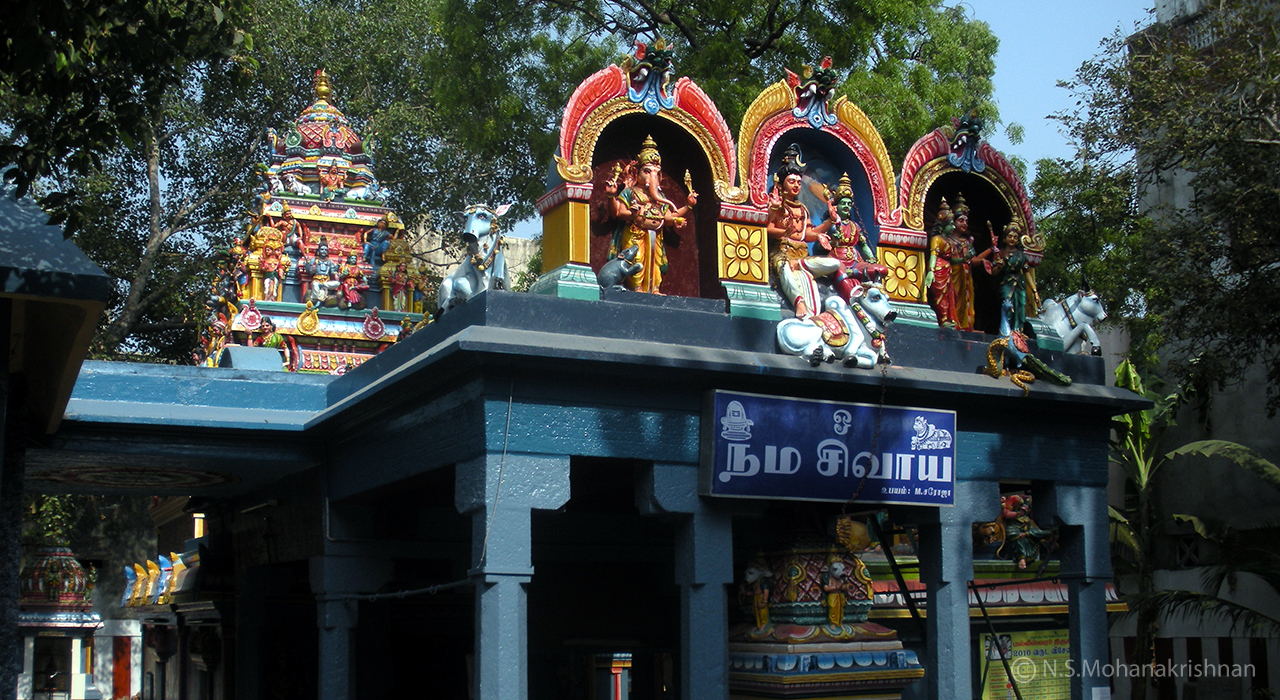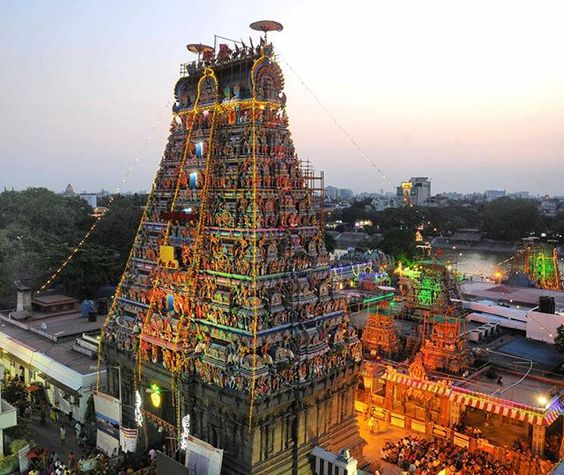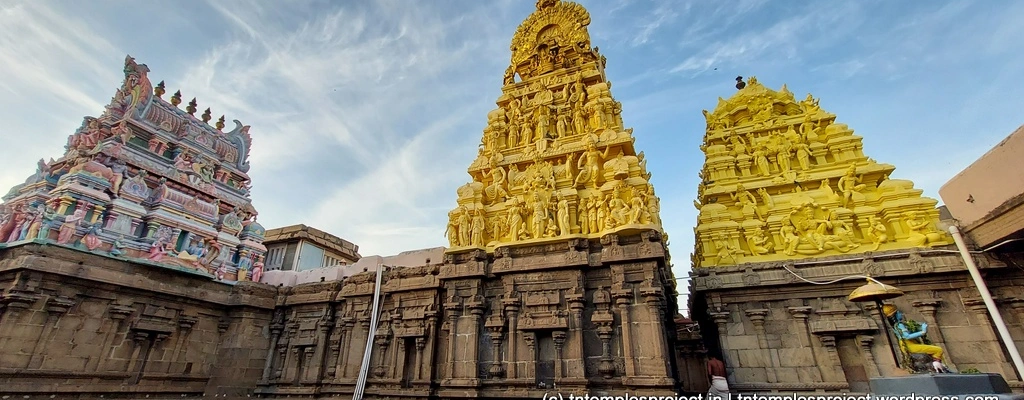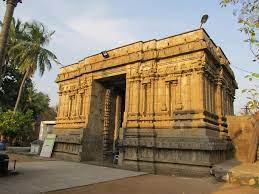TEMPLES IN SOUTH CHENNAI
Chennai is renowned for the distinctive cultural influences that can be seen in the city's numerous architectural wonders. India's southern region has a strong preference for building magnificent temples honouring many deities. Tamil Nadu—and Chennai in particular—is known as the "land of temples" for this reason. It is thought that Tamilians are great sculptors. There seems to be a magnificent temple tucked neatly away in every nook of the city, calling visitors to pay respects to the divine. Visit these temples, learn about their distinctive design features, and develop a strong bond with the Supreme Power. As you approach the Lord and ask for His mercies, feel good feelings and calm flooding over you.
Temples in and around Chennai
Mylapore The Seven Saptha Sthana Shiva temples
The individuals who reside close to a Kshetram are fortunate. Mylapore's Thiru Mayilai is a Kshetram for Saivites and Vaishnavites. It is also known as "Vedapuri," the location where Lord Vishnu rescued Veda from the monster Somukhasura. It is referred to as "Sukrapuri" because "Saint Sukhracharya" was able to see again after performing his penance.
Tirugyana Sambhandar has sung many Devaram hymns about this Kshetram. Saint Arunagirinathar has sung many poems in praise of this Kshetram. This is the birthplace of Tiruvalluvar, Vayilar Nayanar and Vaishnava Azhwars, Poigai Azhwar and Peyazhwar. Hence, this Kshetram is quite significant for both Saivites and Vaishnavites.
Around Mylapore, there are seven significant Shiva temples, the most well-known of which is the Sri Kapaleeswarar Temple. These seven temples are referred to as Saptha Sthaana temples since it is thought that illustrious Sages have adored them. I had been to many of these temples as a child, and now that I knew what each one's significance was, I considered going back. On the Sivarathri day, it is thought that visiting these seven temples will grant a person calm and wealth.
The Seven Saptha Sthana Shiva temples around Mylapore are
Sri Karaneeswarar Temple:
About a kilometre separates his temple from Kapaleeswarar. Sage Vasishta is said to have prayed in this temple. Sri Karaneeswara and Mother Porkodi Amman reside in this temple. It is located along the centre section of Mylapore's Bazar Road. The distance to the Kapali temple is roughly 0.5 kilometres. Karana is a cause. The Lord who is the Cause (Karana + Iswara) is known as Karaneeswara. He is the universe's initial cause because it is his very form. He is also the Lord who can show us the reason for every occurrence.
Sri Theerthapaleeswarar Temple:
This is the second Saptha Sthana Temple that Saint Agasthya dedicated. This temple has the divine energy that Mahaguru Agasthiar gave to Lord Sri Rama when he taught him the Aditya Hridaya mantra. Mother Tripurasundari and Sri Theerthapaleeswarar reside in this temple. On Natesan Street in the Triplicane neighbourhood, there is a significant temple. There were 64 sacred theertha ponds from this temple that extended all the way up to the adjacent sea in antiquity. The Siddhas claim that it is an argya shakti divya sthala. Here, argya worship has been conducted by several rishis.
Sri Velleeswarar temple:
Mother Kamakshi and Sri Velleeswarar reside in this temple. The Kapali temple is located across the street from it on South Mada Street. The Asura Guru Sri Sukrachariar is said to have recovered his sight in this temple thanks to Lord Shiva..
Sri Virupaksheeswarar Temple:
Next to Karaneeswarar Temple on Bazaar Road is the Lord Virupaksheeswarar Temple. Here, Lord Shiva is reported to have a third eye. Lord Virupaksheeswarar is claimed to have been worshipped by Sage Kutsa. In the seventh century, Sri Virupaksheeswarar Temple was constructed. The name Virupakesheeswarar literally translates to "The One with Three Eyes"; the root words "Viroopam" and "Akshi" mean eyes, respectively. Lord Shiva is known as the Lord Virupaksheeswarar because he possesses the divine third eye and can grant a devotee's prayers only by his gaze. In this temple, the goddess Vishalakshi wore a garland made of Virupakshi flowers. The father of the Shri Poompavai, Sri Sivanesa Chettiyar, who tragically passed away at a young age, is thought to have built this temple. Thirugnanasambandhar, one of the most revered Nayanmars, restored her daughter Shri Poompavai back to life from her burned bones. An official temple tank is also located on the temple grounds. The holy water from this tank, known as the Sivagangai, is claimed to cure those who are ill..The main temple's sanctum area is covered in numerous inscriptions. This temple contains inscriptions that date back to the eleventh century..
Sri Vaaleeswarar Temple:
From Virupaksheeswarar Temple, one can easily stroll this temple. The Shivalinga is known as Sri Valeeswarar because it is thought that Sri Vaali, the brother of Sri Sugreeva and Vanara Arasan (King of Monkeys), worshipped Shiva at this temple and strengthened himself. Also, it is thought that the Shiva Linga was first placed by a Rishi by the name of Govardana. It is reported that Sage Gowthama visited this temple. The Lord of power and strength is Sri Valeeswarar. The Puranas claim that worshipping Sri Valeeswarar will result in good physical and mental health as well as a pure heart. Women should worship Valeeswarar for protection and children for courage, respectively.
Sri Malleeswarar Temple:
Our devotion to Sri Malleeswarar in Mylapore grows, and he protects us from all negative ideas and brings us virtue. It is reported that Sage Bhrugu visited this temple. The temple's Sthalapuranam reads as follows. Prarthan, an Ayodhya-based devotee of Lord Shiva, picked this location because it was covered in Malligai (jasmine) bushes. He was then fortunate to have a glimpse of the Lord and his consort "MARAGATHAMBAL" while performing penance. Due to the location of the Lingam, he worshipped, also known as "MALLEESWARAR," it was surrounded by Malligai bushes. In this temple, it is believed that the garlands given and received by "God" and "Goddess" during the "Kalyana Uthsavam" ceremony if worn by an unmarried person and kept at home, will result in marriage. Moreover, Lord Shiva will grant one's requests if a jasmine garland is offered to him six Mondays in a row.
Sri Kapaleeswarar Temple:
Combining the words kapla (head) and vara, a name for Lord Shiva, creates the name of the temple. According to the Puranas, Brahma did not treat Shiva with the proper respect when they first met on Mount Kailash's top. Shiva responded by cutting off one of Brahma's heads (kapalams). Other names for this place include Sukra Puri and Veda Puri, as well as "Kailaye Mayilai and Mayilaye Kayilai," which denotes that this location is comparable to Kailash. Brahma went to the Mylapore location as penance and built a Lingam to appease Shiva. Goddess Karpagambal, a representation of Shiva's consort Parvati, performed penance here after being cursed to become a peahen in order to reclaim her former existence. In this instance, Parvati handed her son Murugan the sword (Sakthi Vel) in return for his victory against an evil spirit. Brahma had come here to worship in order to get rid of his ego and reclaim his creative abilities. The four Vedas were honoured in this place. Thiruvalluvar, the author of the Thirukkural, was also born in Mylapore.
Triplicane
Parthasarathy Temple
In Chennai, India, there is a Hindu Vaishnavite temple called the Parthasarathy Temple that is dedicated to Vishnu. The Thiruvallikeni-area temple is one of the 108 Divya Desams dedicated to Vishnu and is extolled in the Naalayira Divya Prabandham, the early mediaeval Tamil literature canon of the Alvar saints from the sixth to ninth centuries CE. The name Parthasarathy, which refers to Krishna's function as Arjuna's charioteer in the epic Mahabharata, means "charioteer of Arjuna."
It was initially constructed in the sixth century by monarch Narasimhavarman I of the Pallavas. Five different manifestations of Vishnu, including Yoga Narasimha, Rama, Gajendra Varadaraja, Ranganatha, and Krishna as Parthasarathy, are represented by icons at the temple. The temple is one of Chennai's oldest buildings. There are shrines for Swami Manavala Mamunigal, Vedavalli Thayar, Ranganatha, Rama, Gajendra Varadar, Narasimha, Andal, Hanuman, Alvars, and Ramanuja. The temple adheres to Tenkalai tradition and the Vaikhanasa agama. The Parthasarathy and Yoga Narasimha temples have distinct entrances and dhvajastambhas. Extensive sculptures are used to embellish the mandapas and gopurams, which is typical of South Indian temple architecture.
The tank is known as Kairavani and is said to be surrounded by the sacred teerthams of Indra, Soma, Agni, Meena, and Vishnu. Bhrigu, Atri, Marichi, Markandeya, Sumati, Saptaroma, and Jabali were the seven rishis who conducted penance here. Tirumangai Alvar has praised each of the five gods in the temple. One of the 12 Alvars, Andal, who is regarded as the presiding deity's consort, has a separate shrine as well.
One of the few temples in the nation that is dedicated to Krishna as Parthasarathy, Arjuna's charioteer, and that houses the idols of three Vishnu avatars—Narasimha, Rama, and Krishna—is located in this location.
He is unusually shown holding a conch and sporting a noticeable moustache. The iconography arrangement seen in the sanctuary is also remarkable. Standing alongside his wife Rukmini, older brother Balarama, son Pradyumna, grandson Aniruddha, and Satyaki is Krishna. Tiruvallikeni has the reputation of being the Southern Vrindavana as a result of the temple's affiliation with Krishna. He also described the Telliya Singar shrine located inside the temple.
The Hindu Religious and Endowment Board of the Tamil Nadu government is in charge of running the temple. The temple practises vaikanasa aagama and adheres to the Thenkalai sect of Vaishnavite tradition. In the Tamil month of Chittirai (April–May), the temple holds huge brahmotsavams (big festivals) in honour of Sri Parthasarathy swami. During the same month, Udayavar uthsavam is also observed.
Madhyakailas
Madhya Kailash (Tamil: மத்திய கைலாசம்), also known as Nadukkayilai in Tamil, is a Hindu temple in South Chennai, located at the junction between Sardar Patel Road, Adyar and Rajiv Gandhi Salai. It is located opposite the Central Leather Research Institute and is close to the Indian Institute of Technology, Chennai.
Lord Siva, Surya, Devi, and Vishnu shrines surround the "Moolavar," or primary deity, Venkata Ananda Vinayakar. There are also "Sannidhis" to Anjaneya, Swarna Bhairavar, and Onpanko in response to popular demand, albeit these are not Ganapatyam rituals.
The Ananda Vinayagar Temple's Individuality
This temple's Adhyantha Prabhu vigraha is very well sculpted. Lord Ganesha's image is on the right half of the idol, and Lord Hanuman's image is on the left.
In this shrine, 8 bells have been installed. Each one stands for the seven musical swaras (Sa, Ri, Ga, Ma, Pa, Da, Ni, Sa). Om is the eighth sound since it is the initial sound.
The primary deity, Lord Ananda Vinayaka, receives direct sunlight on Vinayaka Chaturthi day. The followers view this as fortunate.
Some devotees have mentioned that camphor could be lit at this Madhya Kailash temple by the devotees themselves.
Every human being is required to execute Pithru Karma, or annual rites, for his or her parents. But that is not very likely because of so many inescapable variables. In order to carry out these funeral rites, the Madhya Kailash temple established the Pitru Kattalai trust. Ananda Vinayakar, who serves as Vinayaka's envoy, is approached by a priest carrying a bundle of Dharbai between midday and 12.30 pm every day. The priest is dressed in a wet cloth after taking a bath. The cooked rice is then waiting for him at the Vishnu Sannidhi according to the number of this specified that day. once the neivedhyam is complete (he is the promoter of the entire process),
It is brought to the shrine of Lord Shiva, who represents Pitru Karma's pinnacle. The rice transforms into pindams there at his shrine, is brought there to Aaditya's shrine, and is then presented to the crows there on a platform.
No mantras are performed because Vinayaka is the Karta, only a salutation to all the pitrus vargam who are wise enough to accept the pindams and bless their generations.
TAMBARAM
Dhenupureeswarar Temple in Madambakkam
The Dhenupureeswarar Temple in Madambakkam, Chennai—also known as Dhenupurisvara and Thiripureeswarar—is a Hindu shrine. The local name for the Hindu god Shiva is Dhenupureeswarar. The temple was built between 956 and 973 CE under the rule of Parantaka Chola II, a Chola king and the father of Raja Raja Chola I, who built Thanjavur's renowned Brihadeeswarar Temple. Like some other Chola temples in and around Chennai, the main sanctum (Sanskrit: garbha griha) is apsidal in shape (Sanskrit: gajaprishta vimana), which is different from most Hindu shrines, which are square or rectangular. It is believed that the temple was stone-consolidated under Kulothunga Chola I.
Both sanctums contain Chola sculptures that have been carefully conserved as well as carved pillar bases.
There are also several exquisite sculptures and inscriptions from the Vijayanagara Empire.
The Archaeological Survey of India has overseen the conservation and restoration of a number of sites, including the temple. The Ancient Monuments and Archaeological Sites and Remains (amendment and validation) 2010 Act, according to the ASI, has designated the temple as a monument of national importance.
Dhenupureeswarar earned the moniker because he granted a cow moksha (Sanskrit: Dhenu). According to legend, Sage Kapila's fault of incorrectly worshipping a Shiva lingam with his left hand caused him to be reborn as a cow. The cow continued to worship Shiva by drizzling milk upon a subterranean Shiva lingam. When the villagers discovered the Shiva lingam, Shiva arrived, granted Kapila moksha (freedom), and pardoned the cowherd who had abused him. The cow had originally been punished by the cowherd for wasting the milk. According to legend, the monarch had a dream about this event occurring here and ordered the construction of the temple as a way to remember it.
Dhenukambal is Dhenupureeswarar's consort in this case. The statue of Dhenupureeswara in linga form is located in the temple's main structure, which faces east. His spouse is located in a separate sanctum and faces south. Swayambhu Lingam, or self-manifested Lingam, is the name of the Shiva Lingam.
VELACHERY
Shiva temple Dandeeswarar Temple
Shiva temple Dandeeswarar Temple (also known as Shri Dandeeswarar Temple) is located in Velachery, a suburb of Chennai. The temple was constructed during the Pallava era, and it underwent repairs and reconstruction during the Chola era. The main temple complex and a tank make up the temple complex, which is located 2 kilometres east of Guru Nanak College on the Velachery main road. The HR & CE Department of the Tamil Nadu government is in charge of running this temple.
The Temple's mythology can be traced back to Lord Yama (God of Death), who is credited with installing this Lingam and asking Lord Shiva for forgiveness and the return of his power after receiving a kick to the chest from the latter in Thirukadavur while trying to save Sage Markandeya's life. Lord Yama is reported to have built a tank (Yama Theertham) and installed this lingam after losing his power. He then passionately begged Lord Shiva for forgiveness and the return of his strength so that he could do his duties in full. As a result of his prayers, Lord Shiva is credited with giving Lord Yama a Staff (Dhandam) and restoring his strength in this location.
The fourth Veda was abducted by Hiranyaksha and held submerged in the sea until being rescued by Lord Vishnu in his Varaha form. The four Vedas came and worshipped this Lord and recovered their vigour as a result. So, this location is suitable for those looking to recuperate their lost vigour and strength. According to legend, Veda Shreni (Pl) is a perversion of the name Velachery.
Yet, as seen by damaged pillars and scattered sculpture fragments, the Temple has historically received poor maintenance. Tamil and Devnagri etchings may be seen on the Pillars. But, because Velachery has developed into a bustling district, the Temple has seen a rise in visitors.
Marundeeswarar Temple
Marundeeswarar is a Hindu shrine to the god Shiva that is situated next to the Bay of Bengal beach in Thiruvanmiyur, Chennai. Two of the most respected Nayanars (Saivite Saints), Appar and Tirugnana Sambandar, praised the temple with their lyrics in the seventh century CE, making it one of the 275 Paadal Petra Sthalams. In the eleventh century CE, the Chola kings greatly increased the size of the temple. Two seven-tiered gateway towers, a sizable tank, and a total area of one acre make up the temple. The Marundeeswarar temple has long been a destination for sick people seeking worship.
The current stone building was constructed in the 9th century by the Chola dynasty, and later additions are credited to the Vijayanagar emperors. The Hindu Religious and Charitable Endowments Department of the Government of Tamil Nadu looks over and manages the temple. Since he taught the wise man Agastya about the therapeutic benefits of many herbs and plants, Marundeeswarar is well-known. Since then, persons with illnesses and other health issues have been able to worship at the Marundeeswarar temple. According to legend, the sage Valmiki, the author of the Ramayana, worshipped Shiva there.
The location was to be called Thiruvalmikiyur, which is pronounced as "Thiruvanmikiyur" in Tamil, but the name gradually changed to Thiruvanmiyur. Valmiki was blessed here. In his honour, Thiruvanmiyur has a neighbourhood called Valmiki Nagar. On what is currently known as the East Coast Road, there is also a shrine for the sage on the western side of the temple (ECR). During the Chola dynasty, Vadagaperuvazhi, the road from Marundeeswarar Temple that is today known as ECR, was a crucial route connecting the kingdom to locations in Thanjavur and Andhra Pradesh.. This historic temple of worship has been given new life twice, first in 1903 and second in the 1970s. The Trinity Sea Shore Temples of Thondai Mandalam are made up of this temple, the Kapaleeswarar Temple, and the Thiruvottiyur Thyagarajaswamy Temple.
SAIDAPET
Karaneeswarar Temple
Hindu temple Karaneeswarar Temple is situated in Chennai, India's Saidapet suburb. Shiva is honoured by having it. The HR & CE division of the Tamil Nadu government currently oversees the management of this historic temple. The name of the goddess is "Swarnambika" (The Golden Mother). In addition to this, there are distinct shrines for Parivara Devtas such as Lord Karthikeya, Lord Ganapathi, and others. In close proximity to the Saidapet Railway station stands this temple.
After entrusting Sage Vashishta with his celestial cow "Kamadhenu," Lord Indra is concerned since she hasn't returned even after a considerable amount of time. He learns that she was cursed to become a common person because she had caused problems during Sage Vashishta's pooja and prayer. He consults his Ganas and learns that if he builds a temple to Lord Shiva between Mylapore and Thiruvanmiyur in the northwestern direction, the Holy Cow Kamadhenu can be redeemed. He then commands the clouds (Kar) to shower and cool the region, resulting in the creation of a beautiful, lush pasture. He builds a Linga and prays to Lord Shiva, who blesses Lord Indra by elevating him to the rank of Gopathi and redeems the sacred cow ( Lord of Cows). The Gopathi Saras is the name of the tank that Indra built. On full moon days, it is reported that those who take a ceremonial bath in this tank are cured of a variety of ailments.
DIVINE TRIP WILL CONTINUE...
















0 Response to "TEMPLES IN SOUTH CHENNAI"
Post a Comment